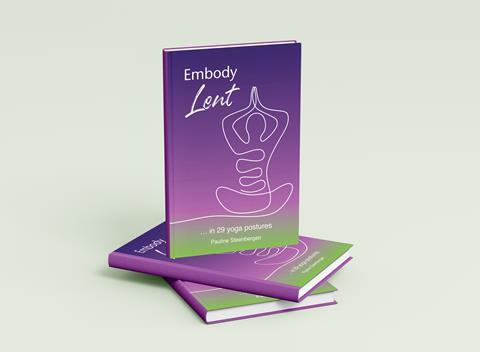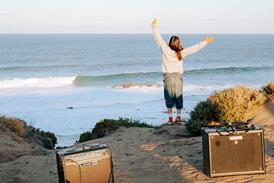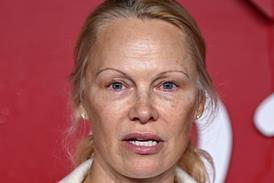In this edited extract from Church of Scotland minister Pauline Steenbergen’s book How to Embody Lent in 29 Yoga Postures she explains how she came to practise yoga, why she teaches it now and introduces some of the poses

Two years after the birth of my son, I took up running in my spare time. A knee injury led me to a sports physiotherapist. She suggested that I go to yoga classes “for a good stretch”. My knee healed. The breath awareness that I discovered in those classes was a surprising bonus, giving me a treasure box of tools to manage anxiety and stress. Around the same time a retired vicar and her friend taught me to meditate using a single word mantra, “Maranatha”. However, it was in my role as a hospice chaplain for children and adults for five years that the significance of every single breath and silent prayer truly dawned on me.
Years later, when it was our time as a family to witness cancer and death, I will never forget sitting in a cottage hospital praying by my mum’s bedside, watching her every breath until she released her final exhalation. The silence in the room after that breath was the deepest peace I’ve ever known.
My faith is underpinned by a belief that God is the breath of life. I feel ‘yoked’ to God’s presence when I simply take the time to become conscious of my breath in and my breath out.
The origins and development of yoga practices
The names of the yoga postures are in Sanskrit and English. This acknowledges that the ethos of the postures originates from the Indian subcontinent, predating all world religions. The yogic bends, twists, stretches, inversions, balances, breathing exercises and meditation techniques have evolved from East to West, from culture to culture, practitioner to practitioner, over centuries. Contemporary yoga in the West is now mainstream and accessible for most ethnicities, ages, abilities, genders, sexualities and body shapes; for all faiths and none. It is one modality among many for exploring embodiment.
The word yoga means ‘yoke’ or ‘unity’. As a yoga teacher in the UK, I see evidence of this on a weekly basis. Here’s an example from my work. Imagine a group of women asylum seekers from Eritrea, Sudan, and Iran placed together in a North Cumbria hotel—Christians, Muslims, humanists, agnostics, and atheists.. Their first languages are not English, but the slow simple phrasing, body postures, breath awareness, relaxation exercises and silent meditation by candlelight create an interconnectedness and a channel for Selam, Salaam, Solh, Peace…which passes all understanding.
Integrating yoga with Christian spirituality
It is a profound privilege to hold spaces in which people can share a common search for more wholeness within themselves, with others, with the earth, with every living thing – and with the Source of our every breath.
Since 2019, inspired by Christine Pickering who founded Maranatha Yoga (maranathayoga.org.uk) in Cumbria, I have been pioneering yoga intersected with Christian spirituality. It’s a joy to create sequences of movement, breath and stillness, rooted in scripture, for diverse groups of people in a variety of contexts.
At its core, How to Embody Lent in 29 Yoga Postures is a holistic exploration of Ecclesiastes 3:1-8. These verses are full of universal opposites, paradoxes and dualisms: “a time to be born and a time to die…a time to love and a time to hate”. The verses intersect well with Lent. This is the season when many Christians focus on Jesus’ confrontation with the oppositional forces of good and evil in the desert, as well as his last days leading to his crucifixion.
There are eight practices, one for each verse, which are suitable to use alone, in a pair or in a group. You can choose some or all of the suggested postures, breathing exercises, reflections, silent meditations and journalling options. I have offered adaptations for chair yoga where applicable. Use each one of your senses to become as embodied as possible in this experience. Depending on the weather, you might like to take your chair and exercise mat outside. Note that uneven ground, frost, snow, wind, rain, cold air, direct sunlight, birds and insects will affect your concentration, balance and posture. In each practice the movements matter but paying close attention to your breath matters equally.
It’s possible to read this book without practising the embodied sequences. There may be reasons why you can’t or don’t want to. Perhaps there will be insights and benefits for you through simply learning more about embodiment and how yoga intersects with Jesus-centred spirituality. The prayer below might mark this beginning:
Optional opening prayer
Jesus, Son of God, you were led
into the desert by the Spirit
for forty days and forty nights.
At the end, angels came and helped you.
We choose to enter into your
embodied experience now
in body, mind and breath.
Maranatha*, Come Lord.
*The phrase Maranatha is made up of two Aramaic words, a language spoken in the time of Jesus. The phrase appears in the New Testament in 1 Corinthians 16:22, meaning ‘Come, Lord’ or ‘The Lord has come’. For many Christians it is an incantation, sounding out the four syllables and sensing Jesus’ real presence with us here and now.
You may desire to enter into the eight practices in this book as a preparation for a time of silent prayer or meditation for 10-30 minutes. It may help to set an alarm. You may want to repeat ‘Maranatha’ in your mind as a singular focal point, yoked to your breathing, to keep your mind on the presence of Jesus. ‘Maranatha’ is the prayer word recommended by The World Community of Christian Meditation wccm.org and Maranatha Yoga UK.
An illustrated guide to five yoga postures

In the book, each embodied practice is illustrated with stick figures and accompanied by a narrative description with prayerful reflection based on Ecclesiastes 3:1-8. Here are some of the postures shared in the book:
1. Tadasana – Mountain pose
Standing indoors or outdoors, perhaps with a wall nearby, or close to an upright bench or chair, plant the whole surface area of each sole, right foot and left foot, on the earth, barefoot if possible. Take time to feel the subtle sway forwards and backwards, from your heels to your toes. You are balancing your entire body weight on your soles. If you prefer, sit down and back in an upright chair and sink your attention into the soles of your feet. This posture can be rooting, fixing us between earth and sky, giving us a sense of permanence, which is balancing when we are aware of impermanence. Find your breath by raising your shoulders, bending your elbows and placing your fingers on your front ribs. Locate your thumbs just around the back of your ribs on each side. Feel the expansion of your ribs to your right and left.
‘There is a time for everything’
2. Sukhasana – Seated easy pose
Sit in an upright chair, or on the floor cross-legged. You might prefer to sit with a wall behind you, or back-to-back with a partner. A cushion under your sitting bones can tilt your pelvis forward to ease tension in this area. Become aware of your natural breathing pattern. Bend your elbows and take one wrist in front of the other one at your pulse points with your thumbs side-by-side and your palms facing you.
Practicing the postures in each chapter leads into guided meditations focusing on Jesus in the desert.
3. Savasana – Corpse pose
Sit at ease in an upright chair, with the soles of your feet planted on the ground. Alternatively, lie down on the ground with your back upon your mat, looking upwards. In either position, if possible, move your feet and legs out to the sides, wider than your hips. Seated in a chair, your knees will still be bent. If lying down, your legs should be long and flat on the floor. Gently place the palms of your hands onto your belly, fingertips touching. Breathe in deeply. Notice the way your belly naturally, without effort, lifts and your fingertips move away from each other. Breathe out and observe how your belly lowers and your fingertips reconnect again in the starting position.
Can you sense how every inhalation and exhalation has its own length and timing?
It is recommended that you consider consulting your GP regarding the suitability of undertaking an exercise programme. When participating in any exercise or exercise programme, there is the possibility of sustaining a physical injury. If you engage in this exercise programme, you agree that you do so at your own risk, are voluntarily participating in these activities and take responsibility for all risk of injury to yourself. Please note, for safe practice, that yogajournal.com/pose-finder has an A–Z of postures with cautions and modifications for various health needs.
4. Apanasana – Supine knees to chest
Lying on your back or sitting towards the front of your chair, pay attention to one knee at a time. Place both hands around your right knee and stretch your left leg forwards, bringing your left heel to the floor. Lift and hug your right knee towards your belly and chest.
After a minute or less, release your right foot to the floor and take both hands over to your left knee. Stretch your right leg forwards, bringing your right heel to the floor. Lift and hug your left knee towards your belly and chest. After a minute or less, release your left foot to the floor and rest. Now, only if you are lying down, bend your knees and bring them upwards so that you can place your right hand on your right knee and left hand on your left knee. Bring both bent knees in towards your chest. Cross one ankle over the other. Then in a clockwise direction circle your knees around three times, and repeat anti-clockwise three times. This warms and massages your spinal column against the floor. If you are in an upright chair, sit in the middle of the chair, place your hands on your lap and gently circle your upper body forward, to the right and back and then left in a clockwise direction three times, and then in an anticlockwise direction three times.
5. Dandasana – L-shaped sitting or staff pose
Sitting on the floor with your spine upright and your feet and legs together straight out in front of you, adopt an L shape. Your knees may be slightly bent. In this rotating yet rounding posture, we practise a seated yoga clock. Place opposite hands on opposite shoulders. Slowly circle from your core and pelvic basin, swaying first to the left and then forwards and to the right and back clockwise and then anti-clockwise, once in each direction. Take time to let all your joints join in the fluidity of the movement. The yoga clock is also possible seated on a chair. With your hands on opposite shoulders, simply circle your upper body as above, with your hips, knees and ankle joints at 90 degrees to the floor and the soles of your feet planted securely on the ground.
As you move physically, is your mind revolving too? We may not always understand the timing of events in our lives, e.g illness, loss or trauma. This first verse of Ecclesiastes chapter 3 may be challenging. We return to it again in prayer: ‘There is a time for everything and a season for every activity under the heavens.’
Pauline Steenbergen is an associate member of the Iona Community, a Church of Scotland minister, a spiritual director, an ecumenical pioneer and a Yoga Scotland teacher. Embody Lent in 29 Yoga Postures is available at ionabooks.com or through your local bookshop. Pauline lives in Carlisle and leads Maranatha Yoga UK, a Fresh Expression made in Cumbria, together with her husband, a retired Anglican vicar. Find out more at limegreenyogi.co.uk Insta: Embody_by_limegreenyogi
Listen to the WA podcast episode: Yoga for Lent? On Premier Plus, Apple Podcasts, Spotify or wherever you get your podcasts.



























No comments yet